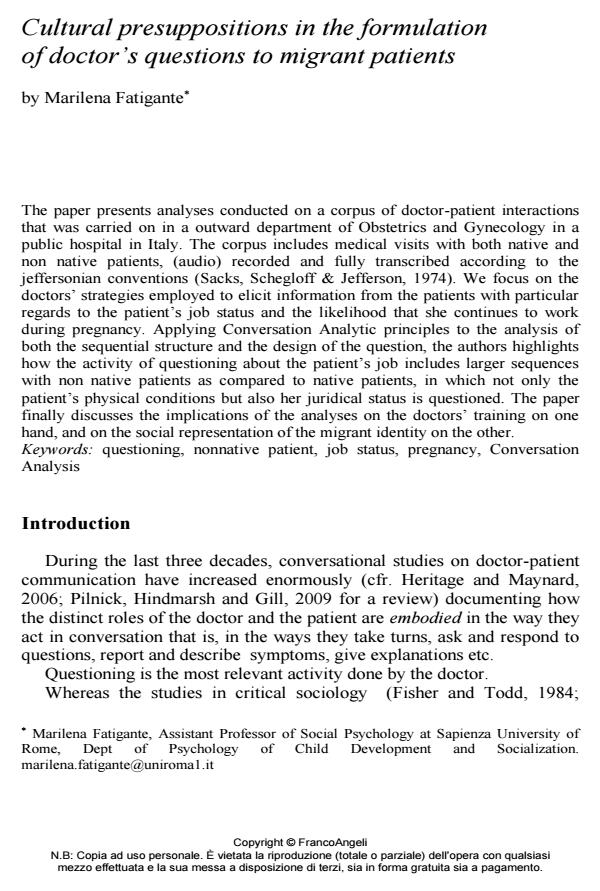Cultural presuppositions in the formulation of doctor’s questions to migrant patients
Titolo Rivista SALUTE E SOCIETÀ
Autori/Curatori Marilena Fatigante
Anno di pubblicazione 2013 Fascicolo 2013/1EN Lingua Inglese
Numero pagine 19 P. 48-66 Dimensione file 389 KB
DOI 10.3280/SES2013-001005EN
Il DOI è il codice a barre della proprietà intellettuale: per saperne di più
clicca qui
Qui sotto puoi vedere in anteprima la prima pagina di questo articolo.
Se questo articolo ti interessa, lo puoi acquistare (e scaricare in formato pdf) seguendo le facili indicazioni per acquistare il download credit. Acquista Download Credits per scaricare questo Articolo in formato PDF

FrancoAngeli è membro della Publishers International Linking Association, Inc (PILA)associazione indipendente e non profit per facilitare (attraverso i servizi tecnologici implementati da CrossRef.org) l’accesso degli studiosi ai contenuti digitali nelle pubblicazioni professionali e scientifiche
The paper presents analyses conducted on a corpus of doctor-patient interactions that was carried on in a outward department of Obstetrics and Gynecology in a public hospital in Italy. The corpus includes medical visits with both native and non native patients, (audio) recorded and fully transcribed according to the jeffersonian conventions (Sacks, Schegloff & Jefferson, 1974). We focus on the doctors’ strategies employed to elicit information from the patients with particular regards to the patient’s job status and the likelihood that she continues to work during pregnancy. Applying Conversation Analytic principles to the analysis of both the sequential structure and the design of the question, the authors highlights how the activity of questioning about the patient’s job includes larger sequences with non native patients as compared to native patients, in which not only the patient’s physical conditions but also her juridical status is questioned. The paper finally discusses the implications of the analyses on the doctors’ training on one hand, and on the social representation of the migrant identity on the other.
Keywords:Questioning, nonnative patient, job status, pregnancy, Conversation Analysis
- Boyd E., Heritage J. (2006). Taking the Patient's Medical History: Questioning During Comprehensive History Taking. In: Heritage J. and Maynard D., editors, Communication in Medical Care: Interactions between Primary Care Physicians and Patients. Cambridge: Cambridge University Press DOI: 10.1017/CBO9780511607172.008
- Byrne P., Long B. (1976). Doctors Talking to Patients. London: DHSS
- Drew P., Heritage J., editors (1992). Talk at work. Cambridge, England: Cambridge University Press
- Fasulo A. (2009). Domande che cominciano per ‘ma’ e per ‘e’. ‘L’epistemica debole’ della conversazione. In: Fatigante M., Mariottini L. e Sciubba M.E., editors, Lingua e Società. Saggi in onore di Franca Orletti. Roma: FrancoAngeli
- Fisher S., Todd A.D., editors, (1986). Discourse and institutional authority: Medicine, Education and Law. Norwood, NJ: Ablex.
- Haakana M. (2001). Laughter as a patient's resource: Dealing with delicate aspects of medical interaction. Text, 21, 1-2: 187-219, DOI: 10.1080/08351813.2011.544221
- Heath C. (1992). The delivery and reception of diagnosis in the general practice consultation. In: Drew P. and Heritage J., editors, Talk at Work. Cambridge: Cambridge University Press
- Heritage J., Raymond G. (in press). Navigating epistemic landscape: Acquiescence, agency and resistance in responses to polar questions. In: deRuiter J. P., editors, Questions: Formal, Functional and Interactional Perspectives. Cambridge: Cambridge University Press
- Heritage J. (2010). Questioning in Medicine. In: Freed A. and Ehrlich S., editors, "Why Do You Ask?": The Function of Questions in Institutional Discourse, New York: Oxford University Press, 42-68.
- Heritage J., Maynard D. (2006). Problems and prospects in the study of doctorpatient interaction: 30 years of research in primary care. Annual Review of Sociology. 32: 351-374 DOI: 10.1146/annurev.soc.32.082905.093959
- Heritage J. (1984). A Change-of-State Token and Aspects of its Sequential Placement. In: Atkinson P. and Heritage J., editors, Structures of Social Action. Cambridge: Cambridge University Press
- Jefferson G. (1989). Preliminary Notes on a Possible Metric which Provides for a ‘Standard Maximum’ Silence of Approximately one Second in Conversation. In: Roger D., and Bull P., editors, Conversation. An Interdisciplinary Perspective. Clevedon: Multilingual Matters
- Linell P., Luckmann T. (1991). Asymmetries in dialogue: some conceptual preliminaries. In: Marková I., and Foppa K., editors, Asymmetries in Dialogue. Hemel Hempstead: Harvester Wheatsheaf, 1-20
- Mishler E. G. (1984). The discourse of medicine: dialectics of medical interviews. Norwood, N.J.: Ablex Pub. Corp
- Orletti F. (2000). La conversazione diseguale. Roma: Carocci
- Parsons T. (1951). The Social System. New York: The Free Press
- Pilnick A., Hindmarsh J. and Gill V. (2009). Beyond 'doctor and patient': Developments in the study of healthcare interactions. Sociology of Health and Illness 31, 6: 787-802 DOI: 10.1111/j.1467-9566.2009.01194.x
- Pomerantz A.M. (1984). Agreeing and Disagreeing with Assessments: Some Features of Preferred/Dispreferred Turn Shapes. In: Atkinson P. and Heritage J., editors, Structures of Social Action. Cambridge: Cambridge University Press.
- Sacks H., Schegloff E.A. and Jefferson G. (1974). A symplest systematics for the organization of turn taking for conversation. Language, 50, 4: 696-735 DOI: 10.2307/412243
- Schegloff E.A. (1972). Sequencing in Conversational Openings. In: Gumperz J. and Hymes D., editors, Directions in Sociolinguistics: The Ethnography of Communication. New York: Holt Rinehart and Winston
- Sorjonen M.L., Raevarra L. Haakana M., Tammi T., and Perakyla A. (2006). Lifestyle Discussions in Medical Interviews. In: Heritage J. and Maynard D., editors, Communication in Medical Care: Interaction between Primary Care Physicians and Patients, New York: Cambridge University Press, 340–78 DOI: 10.1017/CBO9780511607172.014
- Stivers T., Heritage J. (2001). Breaking the sequential mold: Answering “more than the question” during comprehensive history taking. Text, 21, 1-2: 151-185 DOI: 10.1177/019027250707000410
- Stivers T., Majid A. (2007). Questioning children: Interactional evidence ofimplicit bias in medical interviews. Social Psychology Quarterly, 70, 4: 424- 441.
- Todd A. D. (1989). Intimate adversaries: Cultural conflicts between doctors and women patients. Philadelphia: University of Pennsylvania Press
- West C. (1984). Routine Complications: Troubles with Talk Between Doctors and Patients. Bloomington: Indiana University Press
Marilena Fatigante, Cultural presuppositions in the formulation of doctor’s questions to migrant patients in "SALUTE E SOCIETÀ" 1EN/2013, pp 48-66, DOI: 10.3280/SES2013-001005EN